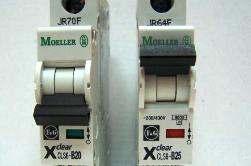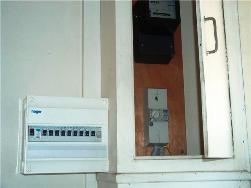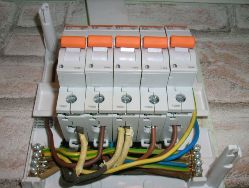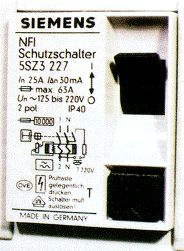Overview of different types of circuit breakers with prices and features
 Circuit breakers are present in any modern building, usually they are mounted on a 35mm DIN rail. The exception is the previously widely used black “automatic machines” of the AE series, which are now better not to use, because they are inferior to modern in all respects except the price.
Circuit breakers are present in any modern building, usually they are mounted on a 35mm DIN rail. The exception is the previously widely used black “automatic machines” of the AE series, which are now better not to use, because they are inferior to modern in all respects except the price.
Circuit breakers (automatic machines) are devices for protecting electrical circuits from overloads and short circuit currents.
A critical situation in the electrical circuit occurs when the load is too powerful, or during a short circuit. To understand how the circuit breaker saves in these situations, you need to understand its principle of operation. When the current in the circuit of the machine exceeds the working one by a factor of several, the thermal release is activated ...
Automata, difavtomats and ouzo, problems of choice
 Classification and practical experience of electrical wiring protection systems
Classification and practical experience of electrical wiring protection systems
Automatic machines or circuit breakers, this is what replaced the usual traffic jams, i.e. fuses in a ceramic case, where a blown wire was a protection against overcurrent.
Unlike plugs, automatic reusable devices and protection functions are separate. Firstly, overcurrent protection, and secondly, overload protection, i.e. the mechanism of the machine breaks the load circuit with a slight excess of the operating current of the machine. In accordance with these functions, the machine contains two types of circuit breakers. Magnetic fast-acting circuit breaker for short-circuit protection ...
How to choose a circuit breaker for home, apartment
 Before choosing a circuit breaker, let's try to figure out what it is and what it is for. So, the circuit breaker is intended, first of all, to protect the supply lines, that is, wires, from overload, short circuit.
Before choosing a circuit breaker, let's try to figure out what it is and what it is for. So, the circuit breaker is intended, first of all, to protect the supply lines, that is, wires, from overload, short circuit.
Most often, to protect the home electrical network, we use machines of the VA series. VA series machines have two types of protection: thermal and electromagnetic. Almost all modern automatic devices are arranged almost the same way: an arcing chamber, a magnetic release and a bimetallic plate, a contact group, a linkage ...
RCD - causes of operation and how to deal with it
 RCD - residual current device. Many probably heard, but someone probably knows what this device is, what it is for and how it works. Without really going into the jungle of physics, we will briefly try to understand the device, the principles of operation of this RCD itself in a simple human language.
RCD - residual current device. Many probably heard, but someone probably knows what this device is, what it is for and how it works. Without really going into the jungle of physics, we will briefly try to understand the device, the principles of operation of this RCD itself in a simple human language.
So, as the name implies, this device is designed to protect against electric shock. The principle of operation of the device is based on a comparison of currents along the conductors at the input and output of the device. The currents must be equal. If there is a slight difference, the device “sees” it and immediately disconnects the load from the network. Response time, by standards, should be no more than 15-25 ms.
Now, in fact, we begin to review the reasons due to which, in practice, the operation of RCDs takes place ...
About electrical protection devices for "dummies": residual current device (RCD)
 Imagine the following - a washing machine is installed in your bathroom. Whatever the well-known brand, devices of any manufacturer are subject to breakdown, and, say, the most banal thing happens - the insulation on the power cord is damaged and the network potential appears on the machine body. And this is not even a breakdown, the machine continues to work, but it is already becoming a source of increased danger.After all, if you touch both the car body and the water pipe at the same time, we will close the electric circuit through ourselves. And in most cases it will be fatal.
Imagine the following - a washing machine is installed in your bathroom. Whatever the well-known brand, devices of any manufacturer are subject to breakdown, and, say, the most banal thing happens - the insulation on the power cord is damaged and the network potential appears on the machine body. And this is not even a breakdown, the machine continues to work, but it is already becoming a source of increased danger.After all, if you touch both the car body and the water pipe at the same time, we will close the electric circuit through ourselves. And in most cases it will be fatal.
To avoid these terrible consequences, RCDs were invented - protective shutdown devices.
An UZO is a high-speed protective switch that responds to differential current in conductors that supply electricity to the protected electrical installation - this is the "official" definition. In a more understandable language, the device will disconnect the consumer from the mains supply if a current leakage occurs to the PE (ground) conductor. Let's consider the principle of operation of the RCD ...
About electrical protection devices for "dummies": circuit breakers
 Many people remember Soviet circuit breakers - plugs. Instead of ordinary ceramic plugs, they were screwed into the shield of an electric meter. It was a compromise solution, which, in general, paid off. Indeed, thanks to this, plugs became "reusable", and without changing the existing design of the electrical panel. In general, the inventor of automatic protection devices is ABB, which patented a small-sized circuit breaker in 1923. Much time has passed since then, but the principle of operation of the circuit breaker has remained unchanged - the restoration of its normal operation with one movement of the hand.
Many people remember Soviet circuit breakers - plugs. Instead of ordinary ceramic plugs, they were screwed into the shield of an electric meter. It was a compromise solution, which, in general, paid off. Indeed, thanks to this, plugs became "reusable", and without changing the existing design of the electrical panel. In general, the inventor of automatic protection devices is ABB, which patented a small-sized circuit breaker in 1923. Much time has passed since then, but the principle of operation of the circuit breaker has remained unchanged - the restoration of its normal operation with one movement of the hand.
A circuit breaker is an electrical switching device designed to conduct current in normal conditions and to automatically turn off electrical installations when short-circuit currents and overloads occur. The most common and popular today are circuit breakers that are mounted on a 35 mm DIN rail in a distribution panel.
The main parameter of circuit breakers is the rated current. This is a current whose value in a particular circuit is considered normal, i.e. for which electrical equipment is designed. For electrical installations in residential buildings, the rated current ...
